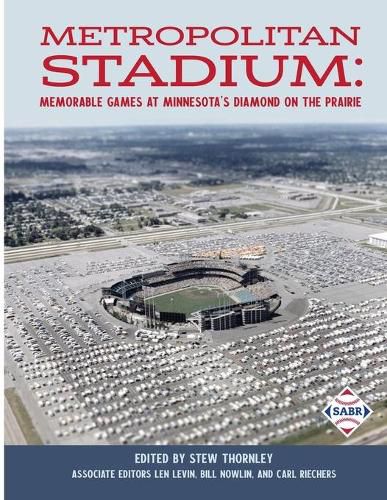Readings Newsletter
Become a Readings Member to make your shopping experience even easier.
Sign in or sign up for free!
You’re not far away from qualifying for FREE standard shipping within Australia
You’ve qualified for FREE standard shipping within Australia
The cart is loading…






This title is printed to order. This book may have been self-published. If so, we cannot guarantee the quality of the content. In the main most books will have gone through the editing process however some may not. We therefore suggest that you be aware of this before ordering this book. If in doubt check either the author or publisher’s details as we are unable to accept any returns unless they are faulty. Please contact us if you have any questions.
Metropolitan Stadium was right on time. It wasn’t built too early, using a cantilever construction that eliminated the need for posts between decks. It wasn’t built too late, staying ahead of the much-maligned cookie cutter multi-purpose stadiums of the 1960s.
The Met followed the trend of other post-war stadiums, sprouting in open areas that were well-served by highways and surrounded by plenty of parking. It became apparent to Minneapolis business and civic leaders that a new stadium would be needed to join the other cities luring major-league baseball to their areas. By the time the Met opened in 1956, the first wave of shifting teams had passed, and Minnesota was snubbed by the New York Giants. The parent team of the minor-league Minneapolis Millers-the stadium’s first tenant-the Giants bypassed Minnesota by switching coasts completely. Eventually, expansion came to the majors and with it the relocation of the Washington Senators, rechristened the Twins.
Ultimately, Met Stadium served the Millers for five years and the Minnesota Twins for 21. In this book, 45 different authors chronicle the significant, memorable, and unusual games that took place in a ballpark that grew out of a cornfield in a southern suburb of Minneapolis. Outdoor baseball in Minnesota often meant postponements and delays because of rain, snow, and even a tornado. (A list of postponements of games for the Millers and Twins is one of the features in this book.) But delays were caused by other reasons, including a bomb threat and a drunk fan climbing the foul pole, and those games are also covered in these pages, as well as memorable performances on the field from players such as Jim Kaat, Harmon Killebrew, Rod Carew, and Bert Blyleven, as well as Cesar Tovar, Camilo Pascual, Tony Oliva, Bob Allison and many more.
$9.00 standard shipping within Australia
FREE standard shipping within Australia for orders over $100.00
Express & International shipping calculated at checkout
This title is printed to order. This book may have been self-published. If so, we cannot guarantee the quality of the content. In the main most books will have gone through the editing process however some may not. We therefore suggest that you be aware of this before ordering this book. If in doubt check either the author or publisher’s details as we are unable to accept any returns unless they are faulty. Please contact us if you have any questions.
Metropolitan Stadium was right on time. It wasn’t built too early, using a cantilever construction that eliminated the need for posts between decks. It wasn’t built too late, staying ahead of the much-maligned cookie cutter multi-purpose stadiums of the 1960s.
The Met followed the trend of other post-war stadiums, sprouting in open areas that were well-served by highways and surrounded by plenty of parking. It became apparent to Minneapolis business and civic leaders that a new stadium would be needed to join the other cities luring major-league baseball to their areas. By the time the Met opened in 1956, the first wave of shifting teams had passed, and Minnesota was snubbed by the New York Giants. The parent team of the minor-league Minneapolis Millers-the stadium’s first tenant-the Giants bypassed Minnesota by switching coasts completely. Eventually, expansion came to the majors and with it the relocation of the Washington Senators, rechristened the Twins.
Ultimately, Met Stadium served the Millers for five years and the Minnesota Twins for 21. In this book, 45 different authors chronicle the significant, memorable, and unusual games that took place in a ballpark that grew out of a cornfield in a southern suburb of Minneapolis. Outdoor baseball in Minnesota often meant postponements and delays because of rain, snow, and even a tornado. (A list of postponements of games for the Millers and Twins is one of the features in this book.) But delays were caused by other reasons, including a bomb threat and a drunk fan climbing the foul pole, and those games are also covered in these pages, as well as memorable performances on the field from players such as Jim Kaat, Harmon Killebrew, Rod Carew, and Bert Blyleven, as well as Cesar Tovar, Camilo Pascual, Tony Oliva, Bob Allison and many more.